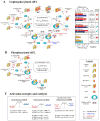eIF2B Mechanisms of Action and Regulation: A Thermodynamic View
- PMID: 29425030
- PMCID: PMC5840040
- DOI: 10.1021/acs.biochem.7b00957
eIF2B Mechanisms of Action and Regulation: A Thermodynamic View
Abstract
Eukaryotic translation initiation factor 2B (eIF2B) is the guanine nucleotide exchange factor of the GTPase eIF2, which brings the initiator Met-tRNAi to the ribosome in the form of the eIF2-GTP·Met-tRNAi ternary complex (TC). The activity of eIF2B is inhibited by phosphorylation of its substrate eIF2 by several stress-induced kinases, which triggers the integrated stress response (ISR). The ISR plays a central role in maintaining homeostasis in the cell under various stress conditions, and its dysregulation is a causative factor in the pathology of a number of neurodegenerative disorders. Over the past three decades, virtually every aspect of eIF2B function has been the subject of uncertainty or controversy: from the catalytic mechanism of nucleotide exchange, to whether eIF2B only catalyzes nucleotide exchange on eIF2 or also promotes binding of Met-tRNAi to eIF2-GTP to form the TC. Here, we provide the first complete thermodynamic analysis of the process of recycling of eIF2-GDP to the TC. The available evidence leads to the conclusion that eIF2 is channeled from the ribosome (as an eIF5·eIF2-GDP complex) to eIF2B, converted by eIF2B to the TC, which is then channeled back to eIF5 and the ribosome. The system has evolved to be regulated by multiple factors, including post-translational modifications of eIF2, eIF2B, and eIF5, as well as directly by the energy balance in the cell, through the GTP:GDP ratio.
Conflict of interest statement
The authors declare no competing financial interest.
Figures



References
-
- Hinnebusch AG. The scanning mechanism of eukaryotic translation initiation. Annu Rev Biochem. 2014;83:779–812. - PubMed
-
- Marintchev A, Wagner G. Translation initiation: structures, mechanisms and evolution. Q Rev Biophys. 2004;37:197–284. - PubMed
-
- Dever TE, Dar AC, Sicheri F. The eIF2α kinases. In: Mathews MB, Sonenberg N, Hershey JWB, editors. Translational Control in Biology and Medicine. Cold Spring Harbor Laboratory Press; Plainview, NY: 2007. pp. 319–344.
-
- Hinnebusch AG. Translational regulation of GCN4 and the general amino acid control of yeast. Annu Rev Microbiol. 2005;59:407–450. - PubMed
Publication types
MeSH terms
Substances
Grants and funding
LinkOut - more resources
Full Text Sources
Other Literature Sources
Miscellaneous

